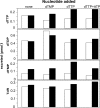Mitochondrial deoxynucleotide pool sizes in mouse liver and evidence for a transport mechanism for thymidine monophosphate
- PMID: 17124168
- PMCID: PMC1693706
- DOI: 10.1073/pnas.0609020103
Mitochondrial deoxynucleotide pool sizes in mouse liver and evidence for a transport mechanism for thymidine monophosphate
Abstract
Dividing cultured cells contain much larger pools of the four dNTPs than resting cells. In both cases the sizes of the individual pools are only moderately different. The same applies to mitochondrial (mt) pools of cultured cells. Song et al. [Song S, Pursell ZF, Copeland WC, Longley MJ, Kunkel TA, Mathews CK (2005) Proc Natl Acad Sci USA 102:4990-4995] reported that mt pools of rat tissues instead are highly asymmetric, with the dGTP pool in some cases being several-hundred-fold larger than the dTTP pool, and suggested that the asymmetry contributes to increased mutagenesis during mt DNA replication. We have now investigated this discrepancy and determined the size of each dNTP pool in mouse liver mitochondria. We found large variations in pool sizes that closely followed variations in the ATP pool and depended on the length of time spent in the preparation of mitochondria. The proportion between dNTPs was in all cases without major asymmetries and similar to those found earlier in cultured resting cells. We also investigated the import and export of thymidine phosphates in mouse liver mitochondria and provide evidence for a rapid, highly selective, and saturable import of dTMP, not depending on a functional respiratory chain. At nM external dTMP the nucleotide is concentrated 100-fold inside the mt matrix. Export of thymidine phosphates was much slower and possibly occurred at the level of dTDP.
Conflict of interest statement
The authors declare no conflict of interest.
Figures






Similar articles
-
Deoxyribonucleotide pool imbalance stimulates deletions in HeLa cell mitochondrial DNA.J Biol Chem. 2003 Nov 7;278(45):43893-6. doi: 10.1074/jbc.C300401200. Epub 2003 Sep 17. J Biol Chem. 2003. PMID: 13679382
-
Mitochondrial deoxyribonucleotides, pool sizes, synthesis, and regulation.J Biol Chem. 2004 Apr 23;279(17):17019-26. doi: 10.1074/jbc.M313957200. Epub 2004 Jan 26. J Biol Chem. 2004. PMID: 14747464
-
Origins of mitochondrial thymidine triphosphate: dynamic relations to cytosolic pools.Proc Natl Acad Sci U S A. 2003 Oct 14;100(21):12159-64. doi: 10.1073/pnas.1635259100. Epub 2003 Sep 30. Proc Natl Acad Sci U S A. 2003. PMID: 14519855 Free PMC article.
-
A kinetic model of regulation of the deoxyribonucleoside triphosphate pool composition.Pharmacol Ther. 1984;24(2):279-301. doi: 10.1016/0163-7258(84)90038-x. Pharmacol Ther. 1984. PMID: 6379685 Review. No abstract available.
-
Changes in deoxynucleoside triphosphate pools induced by inhibitors and modulators of ribonucleotide reductase.Pharmacol Ther. 1985;30(1):31-42. doi: 10.1016/0163-7258(85)90046-4. Pharmacol Ther. 1985. PMID: 3915820 Review.
Cited by
-
Membrane association of mitochondrial DNA facilitates base excision repair in mammalian mitochondria.Nucleic Acids Res. 2010 Mar;38(5):1478-88. doi: 10.1093/nar/gkp1143. Epub 2009 Dec 10. Nucleic Acids Res. 2010. PMID: 20007607 Free PMC article.
-
Thymidine kinase 2 (H126N) knockin mice show the essential role of balanced deoxynucleotide pools for mitochondrial DNA maintenance.Hum Mol Genet. 2008 Aug 15;17(16):2433-40. doi: 10.1093/hmg/ddn143. Epub 2008 May 8. Hum Mol Genet. 2008. PMID: 18467430 Free PMC article.
-
C-terminal extension of the yeast mitochondrial DNA polymerase determines the balance between synthesis and degradation.PLoS One. 2012;7(3):e33482. doi: 10.1371/journal.pone.0033482. Epub 2012 Mar 14. PLoS One. 2012. PMID: 22432028 Free PMC article.
-
Ribonucleotide reductase is not limiting for mitochondrial DNA copy number in mice.Nucleic Acids Res. 2010 Dec;38(22):8208-18. doi: 10.1093/nar/gkq735. Epub 2010 Aug 19. Nucleic Acids Res. 2010. PMID: 20724444 Free PMC article.
-
The human SLC25A33 and SLC25A36 genes of solute carrier family 25 encode two mitochondrial pyrimidine nucleotide transporters.J Biol Chem. 2014 Nov 28;289(48):33137-48. doi: 10.1074/jbc.M114.610808. Epub 2014 Oct 15. J Biol Chem. 2014. PMID: 25320081 Free PMC article.
References
-
- Bogenhagen D, Clayton DA. Cell. 1977;11:719–727. - PubMed
-
- Rampazzo C, Ferraro P, Pontarin G, Fabris S, Reichard P, Bianchi V. J Biol Chem. 2004;279:17019–17026. - PubMed
-
- Ferraro P, Pontarin G, Crocco L, Fabris S, Reichard P, Bianchi V. J Biol Chem. 2005;280:24472–24480. - PubMed
-
- Nishino I, Spinazzola A, Hirano M. Science. 1999;283:689–692. - PubMed
-
- Saada A, Shaag A, Mandel H, Nevo Y, Eriksson S, Elpeleg O. Nat Genet. 2001;29:342–344. - PubMed
Publication types
MeSH terms
Substances
Grants and funding
LinkOut - more resources
Full Text Sources
Research Materials

